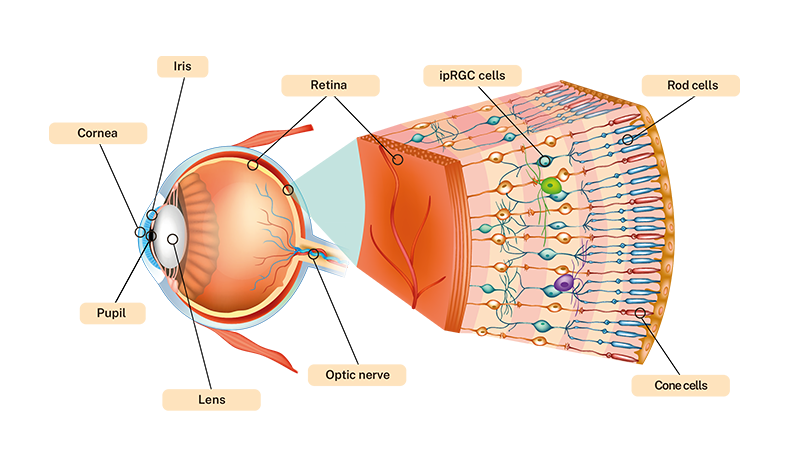For a long time, researchers have been trying to understand what controls our circadian rhythm. There was a strong belief that our eyesight must be the thing determining when it is day and night. However, experiments with blind individuals proved otherwise, revealing that it may not be so simple after all.
In the eye, we also have some light-sensitive cells that are not part of our vision - meaning that our eye perceives light in a way that we do not see. These light-sensitive cells have the catchy name 'intrinsically photosensitive retinal ganglion cells (abbreviated as ipRGC cells), and they are the ones that detect light for our circadian rhythm and also control the size of our pupils. So, the eye is an organ with both a visual and a non-visual function, but what does it consist of?
How is the eye structured?
The eye is a small yet sophisticated organ, composed of several anatomical elements such as:
- Cornea: The outer part of the eye is made up of a transparent, curved structure known as the cornea. Serving as a protective barrier, the cornea not only shields the eye but also aids in allowing light to enter.
- Pupil and Iris: Behind the cornea lies the pupil, which is the dark opening in the centre of the eye. The iris, the coloured part of the eye, controls the size of the pupil. The iris expands or contracts the pupil to regulate the amount of light entering the eye.
- Lens: Positioned just behind the pupil, the lens is a transparent structure that has the remarkable ability to change its shape in order to focus the rays of light onto the retina. It is the lens that enables us to achieve sharpness in our vision, allowing us to perceive objects both near and far with clarity.
- Retina: The retina is a layer of light-sensitive sensory cells located at the back of the eye. It is where the actual detection of light occurs. The retina contains two types of photoreceptor cells: rods and cones, but it is also here that the light-sensitive cells, ipRGCs, have been discovered.
- Rods are responsible for our ability to see in dim light conditions such as twilight in the evening or early morning. They are highly light-sensitive and cannot distinguish colours, so everything seen with rod cells appears in black and white.
- Cones are highly sensitive to colours, allowing us to perceive intricate details and the full spectrum of colours in our vision. There are three types of cones, each capable of recognizing a specific colour: blue, red, and green. Unlike rods, cones are less sensitive to light, which means that we can only perceive colours when there is a certain level of brightness.
- ipRGCs are responsible for our biological reactions to light. These cells contain a protein called melanopsin, which is sensitive to blue light. When these ipRGCs detect blue light, they send impulses to the brain that impact our circadian rhythm, influencing a wide range of our body's biological processes.
- Optic Nerve: When light is detected by the photoreceptor cells (rods and cones), it is transformed into electrical impulses that travel through the optic nerve to the brain.
- Brain: It is within the intricate workings of the brain that the electrical impulses from the eye are processed and translated, not only into the visual images and perceptions that we are able to see and comprehend but also into the non-visual perceptions of light and darkness.
Light's Journey: From the Cornea to the Brain
When light enters the eye, it passes through several layers of cells. First, it is refracted by the cornea, then it continues through the pupil. The light is then bent by the lens and projected onto the retina through the vitreous humor, where the actual image is formed - albeit upside down. On the retina, there are light-sensitive sensory cells shaped like rods and cones. When stimulated by light, they emit an electrical signal that travels through the optic nerve to the brain, where perception takes place. However, as mentioned before, our eyes are responsible for more than just image formation.
The Eye's Multifaceted Functions
The eye, like our ears, has multiple functions that include both vision and non-visual processes. The visual system sends information to our brain about the shapes and colours we see, while the non-visual system detects light and transmits it to a small centre deep within our brain called the suprachiasmatic nucleus. From there, the signal is used to coordinate the physiological processes in our body that depend on the time and rhythm of the day, such as hunger, digestion, hormone production, sleep, wakefulness, and much more. In fact, nearly all functions in our body rely on timing and coordination to function properly and keep us feeling well. When we are sick, for instance, it is extremely important to regain a healthy circadian rhythm, which can be disrupted by lack of light, unconsciousness, the illness itself, or as a self-defence mechanism against certain critical diseases. The eye is a complex organ with functions that allow us to perceive both visual light to see the world and non-visual light that regulates our internal endocrine functions, including our circadian rhythm.


